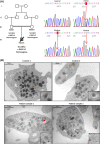A novel missense variant in SLC18A2 causes recessive brain monoamine vesicular transport disease and absent serotonin in platelets
- PMID: 31240161
- PMCID: PMC6498820
- DOI: 10.1002/jmd2.12030
A novel missense variant in SLC18A2 causes recessive brain monoamine vesicular transport disease and absent serotonin in platelets
Abstract
Background: Brain monoamine vesicular transport disease is an infantile onset neurodevelopmental disorder caused by variants in SLC18A2, which codes for the vesicular monoamine transporter 2 (VMAT2) protein, involved in the transport of monoamines into synaptic vesicles and of serotonin into platelet dense granules.
Case presentation: The presented case is of a child, born of healthy consanguineous parents, who exhibited hypotonia, mental disability, epilepsy, uncontrolled movements, and gastrointestinal problems. A trial treatment with L-DOPA proved unsuccessful and the exact neurological involvement could not be discerned due to normal metabolic and brain magnetic resonance imaging results.Platelet studies and whole genome sequencing were performed. At age 4, the child's platelets showed a mild aggregation and adenosine triphosphate secretion defect that could be explained by dysmorphic dense granules observed by electron microscopy. Interestingly, the dense granules were almost completely depleted of serotonin. A novel homozygous p.P316A missense variant in VMAT2 was detected in the patient and the consanguineous parents were found to be heterozygous for this variant. Although the presence of VMAT2 on platelet dense granules has been demonstrated before, this is the first report of defective platelet dense granule function related to absent serotonin storage in a patient with VMAT2 deficiency but without obvious clinical bleeding problems.
Conclusions: This study illustrates the homology between serotonin metabolism in brain and platelets, suggesting that these blood cells can be model cells for some pathways relevant for neurological diseases. The literature on VMAT2 deficiency is reviewed.
Keywords: epilepsy; platelet dense granules; serotonin; vesicular monoamine transporter 2; whole genome sequencing.
Conflict of interest statement
Manisha Padmakumar, Jaak Jaeken, Vincent Ramaekers, Lieven Lagae, Daniel Greene, Chantal Thys, Chris Van Geet, NIHR BioResource, Kathleen Stirrups, Kate Downes, Ernest Turro, and Kathleen Freson declare that they have no conflict of interest.
Figures


References
Publication types
LinkOut - more resources
Full Text Sources

